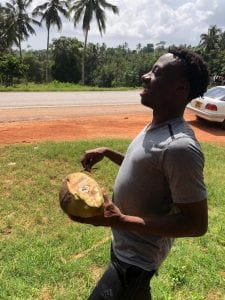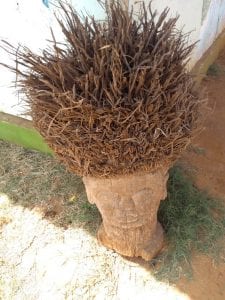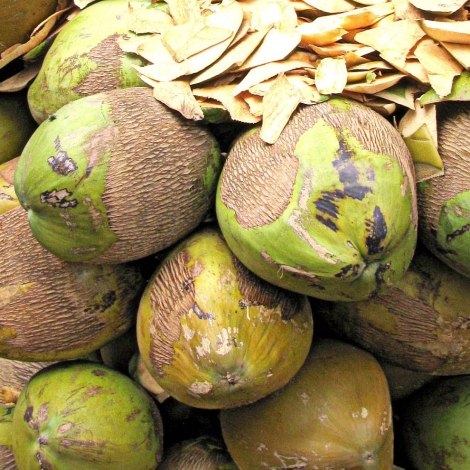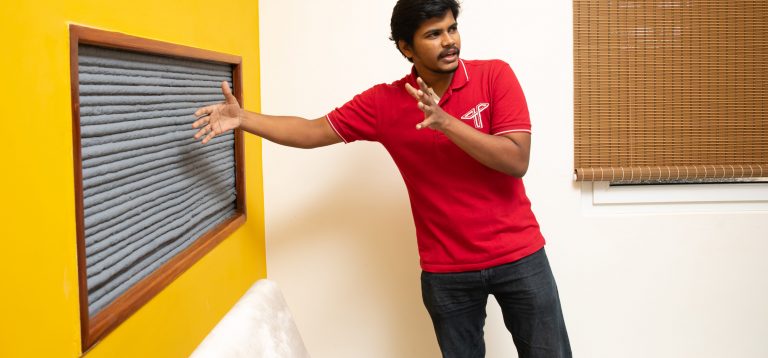“Kaukumbatie mnazi ukaupande, kazi uanze” (Embrace the coconut tree and climb it, start work) – mnazi Swahili proverb
“The starting point for your coconut shell-based building materials program should be in the area of improved agronomy practices” – that was how the Chief Officer for Agriculture in one of Kenya’s Coastal counties welcomed us during a field visit directed at understanding the coconut value chain. Since 2008, Dr. Esther Obonyo, one of the authors, has been investigating locally sourced materials in the design of affordable, resilient and healthy building envelopes.
The interest in coconut materials (Coco-Mat) was sparked by a project supported by Pennsylvania State University’s Material Research Institute through the Covestro Humanitarian Materials Initiative. We are adopting a small-scale, materials science-enabled, experimental approach to generate empirical data for building scale-prediction models. The models can inform the design and construction of sustainable, adequate, functional and more affordable shelters for resource-constrained contexts. Kenya in East Africa will be the sites of initial deployment.

A hawker husks the coconut and prepares it for drinking straws at a market in Mombasa, Kenya. Photo: Luigi Guarino (CC BY 2.0)
The most common pollutants in low-income and emerging economies come from biomass fuels such as firewood and charcoal. These are typically the most commonly used energy sources for cooking. According to the World Energy Outlook, in 2013 more than 2.7 billion people (38 percent of the world’s population) relied on the traditional use of solid biomass for cooking, typically using inefficient stoves in poorly ventilated spaces (IEA, 2016). In Sub-Saharan Africa (SSA), more than 90 percent of the population relies on firewood and charcoal for cooking and heating (IEA, 2006). In Kenya, about 90 percent of rural households and 7 percent of urban households (an average of 70 percent of all households) use firewood (MoE 2002).
Carbon monoxide (CO) is one of the main products of incomplete combustion of biomass. Annual global estimates are estimated to be in the range of 2040 to 3315 teragrams. This has an adverse impact on the climate and living things, including humans. Clearly, we will not be able to make wood fuels sustainable and acceptable until we find a way to address the damage combustion does to indoor air quality. We acknowledge that there is value in the efforts taken to address this problem through clean cookstoves and the like. This notwithstanding, the problem is far from a resolution. Globally, as many as 4.3 million people die from illnesses associated to pollutants from biomass fuel (Lim and Vos, 2012).
From a shelter perspective, the quality of indoor air is a critical factor in sustainability and functionality. Cleaner indoor air can be attained through controlling or eliminating the source of pollutants, and by ventilating the home with clean outdoor air. Ventilation may be limited by weather conditions or the levels of contaminants in the outdoor air.
 Through collaborating with colleagues in Engineering Science and Materials Science, we tested the CO uptake in coconut char (coconut charcoal). Our findings were consistent with those obtained by Huang et al – there was a decrease in CO gas that can be attributed to adsorption on activated carbon from coconut shells.
Through collaborating with colleagues in Engineering Science and Materials Science, we tested the CO uptake in coconut char (coconut charcoal). Our findings were consistent with those obtained by Huang et al – there was a decrease in CO gas that can be attributed to adsorption on activated carbon from coconut shells.
Armed with our own evidence that our material of interest had potential as a medium for CO adsorption, the three of us traveled to Kenya to study the coconut value chain. Based on a series of conversations with a colleague who had done some work with coconut shells in the Philippines, we had established that it is possible to set a facility that produces coconut char in a rural coastal area where we believed we would find the coconut shells. As part of due diligence, we spent a week in Kilifi gathering preliminary data on the key factors along the coconut value chain that have a direct bearing on the primary input material, the coconut shells.
We invited a Tanzanian associate to accompany us and help identify opportunities for synergies at the regional level. There are shared experiences of the communities native to the coastal areas of Kenya and Tanzania. To our pleasant surprise, all the locals we interacted with pointed at our Tanzanian associate as our best ally when we indicated that our goal was coconut-shell related. We learned that the market for coconut may have shifted into a monopoly, with a Tanzania-based tycoon making lump-sum payments to farmers for exclusive rights to coconuts based on the number of trees they own. Unless something truly transformative happens with respect to giving the farmers an incentive to sell more of their coconuts to the local market, the people we met are right: our proposed coconut char facility will have to be located in Tanzania. We are maintaining an open mind and will explore this option further and an objective manner as part of our follow-up activities.
Meanwhile, we cannot ignore the apparent lack of sustainability in the existing coconut value chain. The most obvious problem is the long-term financial sustainability, or lack thereof. Our position is informed in part by the difficulties we experienced when trying to identify East African coconut products in the supermarkets. There were very few local products. The coconut-related consumer goods from either the Middle East or Southeast Asia. The carbon footprint of such products is a problem that needs to be addressed.
 The locals we met had impressive knowledge of the potential of the coconut palm. Our guide wanted us to appreciate that the area is populated by more than one of the nine Miji Kenda ethnic groups. He suggested that the area may be representative of other locations long the Kenyan coast. The Miji Kenda people had a consistent message. They hold that the mnazi (coconut palm tree) is one of the most valuable trees in the world because “every part of the mnazi can be used.” They talked passionately about all the products that can be derived from the mnazi using a cottage-industry approach.
The locals we met had impressive knowledge of the potential of the coconut palm. Our guide wanted us to appreciate that the area is populated by more than one of the nine Miji Kenda ethnic groups. He suggested that the area may be representative of other locations long the Kenyan coast. The Miji Kenda people had a consistent message. They hold that the mnazi (coconut palm tree) is one of the most valuable trees in the world because “every part of the mnazi can be used.” They talked passionately about all the products that can be derived from the mnazi using a cottage-industry approach.
We got confused when one of the locals said: “The roots are used to make hair,” while pointing at Dr. Obonyo’s braided hair! Our guide clarified things for us: artists use it to represent hair in their craftwork. The roots also have medicinal properties. The locals cited urinary infections, skin disorders and fever as examples of ailments that can be treated using extracts from the roots.
The coconut kernel, which is the flesh, or the white edible part of the coconut, is a critical ingredient in the cuisine of coastal communities in East Africa. The high protein, vitamin-rich coconut kernel can be eaten raw or cooked, or processed to manufacture other products. It is also grated, mixed with water and squeezed to produce coconut milk or cream. During our visit, we extracted 100ml of coconut oil from half a coconut. The locals shared that the oil can be used for cooking, preventing hair damage and also as a skin moisturizer. To our surprise, most of the locals buy coconut milk and oil from the nearby retail stores.
Coconut water is also very popular among the locals. One of the people we met wanted us to have the full coconut water experience. He brought down coconuts at several different stages through which we saw a “farm to table” opportunity for providing different flavors to suit individual preferences. In subsequent conversations with an expert who works closely with medical doctors, we learned that fresh coconut water is high in B vitamins, proteins and ascorbic acid. There is also evidence that coconut water can be used to treat stomach ache and urinary problems.
A lot of the coir and shells are discarded. This was surprising because the people we talked to knew that this “waste” had value.
The coir and coconut shell may present opportunities for transforming waste into resources. A lot of the coir and shells are discarded. This was surprising because the people we talked to knew that what was currently being discarded by some people as “waste” had value. They shared that the coir can be used as a scouring pad to wash dishes. A few people use it for fuel. There was an understanding of the potential use of the shell as a source of fuel but this is no longer a common practice. The shell is also used by artisans to create jewelry and other ornaments.
In some of the areas we visited, we were impressed by the weaving skills of women and their daughters. They wove palm leaves into hats, baskets, mats and roof-thatching materials. Most of these items were sold at relatively low prices in local markets. The midribs (middle section of the palm leaves) is used to make brooms and as a beam in building construction. From what we observed and confirmed through conversations with the locals, the use of midribs in construction is mostly in the self-build units. Most of these items are sold at relatively low prices in the local markets
We found out that there was high demand for what the locals referred to as the kilele, the heart of the coconut tree, which is found right underneath the leaves. The Indian community in the coastal parts of Kenya use it for medicinal purposes. The agricultural experts we consulted indicated that extracting the kilele “kills” the tree.
Locals have impressive knowledge of several ways through which one can unlock value from the coconut palm tree.
We asked one of the first locals we met: “How do your pay school fees for your children?” He signaled his mgema (wine tapper) to go up the tree. He (the mgema) brought down samples of creamy looking fluid that our guide identified as high quality mnazi wine. Some of the palm wine is air-lifted to Nairobi on a daily basis. We were told that the palm wine pays school fees for children from three families – the palm tree owner, the mgema and also our retail partner in the market. From a humanitarian perspective there is a problem because excessive tapping of mnazi wine is detrimental to the tree; it reduces its life span.
From the foregoing, it is clear that the locals have impressive knowledge of several ways through which one can unlock value from the coconut palm tree. There are, however, some choke points along the coconut value chain that are limiting their ability to realize this value. As mentioned, some of these issues are more on the agronomy side. There was a strong interest in the establishment of a research-and-development facility that could help promote good agronomy practices. We established through our interactions with subject matter experts that there is a deficit in coconut production in Tanzania. Coconut production in Kenya has also been declining. If the trend prevails, Kenya is on track to experiencing a deficit in local production similar to what has happened to Tanzania within the next 5-10 years.
Low coconut production is a problem and it can be linked directly to easy-to-fix problems such as improper spacing.
In our conversation with the Chief Officer for Agriculture, we identified the trunk of the coconut tree as a low-hanging fruit (no pun intended) for our humanitarian materials initiative. Currently, the coconut palm tree is not being farmed as a crop using principles of good agronomy. Consequently, low coconut production is a problem and it can be linked directly to easy-to-fix problems such as improper spacing. The density of trees in each parcel of land is on the higher side. One of the limiting factors here is lack of demand for commercial use of the trunk. Interestingly, we know that coconut timber extracted from the trunk can be used as a substitute for hardwood. We observed that some houses use coconut timber in roof trusses, but those were generally modest-sized self-built homes.
These trusses were visibly more termite resistant compared to elements in the structures that were derived from other tree species. As previously indicated, the coconut tree is used as a construction material in this context primarily in the self-build sector. There is, however, high demand for alternative building materials in East Africa. Promoting an uptake of coconut timber in the formal construction sector will give the land owners incentive to adhere to good agronomy practices and uproot some of their coconut trees to space them appropriately. The result could add an income stream to coconut farmers and possibly thin the groves to allow more robust growth.
The coconut trade from Kenya to Tanzania should be realigned using the principles of the circular economy.
During deliberations with a collaborator in the financial sector, we identified a hidden layer of problems that orbit the big problem of the lack of livelihood diversification and financial literacy in most rural households. Some of the locals told us that their parents’ generation had received lump sum payments for coconuts that resulted in an accumulation of debts that took them 20-25 years to pay off. The commercially engaged, coconut-producing households can benefit from having other revenue streams beyond selling coconuts and mnazi wine. As long as the household members are either living from hand to mouth or financially strained by the effects of long-term debt, they will not fully embrace the kind of financial literacy training that they need. Promoting the uptake of coconut timber in the formal construction sector would address some of the need for diversification of livelihoods; it would add a new income stream to coconut farmers.
The coconut trade between Kenya and Tanzania should be realigned using the principles of the circular economy. We are, as part of our follow-up activities, exploring ways of transforming waste into usable resources. Such a shift could be profitable for both countries. Having the primary processing done locally in Kenya will reduce both the carbon footprint and direct finance costs associated with transporting coconuts over 300 miles between Mombasa and Dar es Salaam. Processing coconut cream locally will address the scarcity of coconut problem plaguing local operators who have traditionally earned their living and created jobs for the community through this commodity. During conversations with one them, he indicated that throughout most of 2018, his plant was mostly idle because “all the coconuts had been taken to Tanzania.”
There is a golden opportunity hidden in coconut shells: high quality coconut char.
What’s in it for the Tanzanian tycoon? A mutually beneficial partnership would result in his products being stocked in more supermarkets in the region. The Tanzania-based tycoon who is currently dominating the coconut market in the region is also uniquely positioned to take on the production of high-end coconut products. In the long term, we see someone like the tycoon, a person who is considered by many as the most successful businessman in East Africa, as the key to unlocking a golden opportunity hidden in coconut shells: high quality coconut char. It is a premium commodity used in the manufacture of electrodes and supercapacitors. True transformation will require thinking beyond regional markets. In our follow-up activities we are exploring how our vision for innovation in coconut-based materials can leverage existing incentives and access to global markets that favor Kenya and Tanzania.
We accept the invitation by the Chief Officer for Agriculture to partner with him in his efforts to help coastal households invest in the coconut palm tree as a crop. We are ready to take on the challenge posed by our subject matter expert for all things finance-related: embracing the coconut value chain fully requires one to think of it as a business operation. We have embraced the coconut tree; we have climbed it; we have started work.
References
Khambali Setiawan Sukiran Al Jauhari Lecturer in Health Ministry Health Polytechnic, Surabaya, East Java, Indonesia, Activated Carbon Adsorption Effectiveness in Coconut Shell Lowers Carbon Monoxide Indoor Air ournal of Environment and Earth Science www.iiste.org ISSN 2224-3216 (Paper) ISSN 2225-0948 (Online) Vol.5, No.22, 2015.
Pei-Hsing Huang, Hao-Hsiang Cheng, and Sheau-Horng Lin (2015), Adsorption of Carbon Dioxide onto Activated Carbon Prepared from Coconut Shells, Journal of Chemistry, vol. 2015, Article ID 106590, 10 pages. https://doi.org/10.1155/2015/106590
David R. Tilley & Jeff Mentzer (2006) Soil Uptake of Carbon Monoxide Emitted in the Exhaust of a Gasoline-Powered Engine, Journal of the Air & Waste Management Association, 56:2, 115-120, DOI: 10.1080/10473289.2006.10464451
About the Authors
Dr. Esther Obonyo is an Associate Professor of Engineering Design and Architectural Engineering at the Pennsylvania State University. She has had several NSF awards including an International Research Experiences for Students directed at Developing Global Scientist and Engineers. The participants in the program completed research training in Kenya and Tanzania in a project directed at: 1) Characterizing the differences in approaches to sustainable construction engineering between developed countries, such as the USA, and developing countries, such as Kenya, and define a framework for global learning; 2) Investigating the appropriateness of construction engineering approaches used by the different types of builders in developing economies using suitable assessment models; 3) Contextualizing innovative and low cost use of building materials, water and sanitation systems that are both sustainable and affordable and; 4) Demonstrating sustainable building systems that exploit cross-fertilization of ideas across the different regions in the research.
Brian Machoka and Carlton Wasike, students in the College of Engineering at Penn State University, contributed to this article.


Good essay but looks like an undergraduate project! Considering the technical value of materials as provided by nature is important. Burning a material as a waste is itself a wasteful process. Coconuts from coconut water as a drink to the hard kernel stage yields various food products. As the coconut matures, the kernel can be used as a food product, the fiber can be made into ropes and used for many uses, the hard shell can be pulverized and converted into particle boards, the palm leaves, the reeds, and the trunk can all be used in various ways. Engineering professors should undertake such wide ranging projects to help the economics of the rural communities.